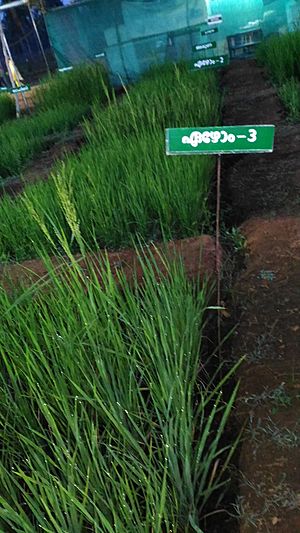Ezhome Rice facts for kids
Quick facts for kids Ezhome Rice |
|
|---|---|

Ezhome paddy cultivation at the Regional Agricultural Institute at Pilicode, Kasaragod district
|
|
| Cultivar group | Ezhome Rice |
| Origin | Kerala |
| Cultivar group members |
|
Ezhome Rice refers to two special types of rice, Ezhome-1 and Ezhome–2. These are the first high-yielding, organic red rice varieties that do not fall over easily. They were created especially for the salty Kaipad rice fields in Kerala, India.
These rice varieties have grains that do not have awns (bristle-like parts) and do not scatter easily when harvested. They also have great cooking qualities, even better than older local rice types.
Contents
Why Ezhome Rice is Important
Ezhome Rice varieties are very important for farmers in salty areas. They help farmers grow more food and earn more.
High Yields for Farmers
The 'Ezhome-1' variety can produce about 3.5 tonnes of rice per hectare. 'Ezhome-2' can yield about 3.2 tonnes per hectare. This is a lot more rice! It's about 70% more for 'Ezhome-1' and 60% more for 'Ezhome-2' compared to traditional rice varieties grown in the same conditions. This means farmers get a much bigger harvest.
Growing in Salty Water
The Kaipad rice fields in Kerala often have salty water. Most rice plants struggle to grow in such conditions. However, Ezhome Rice varieties have special ways to deal with the salt. This makes them perfect for these unique fields. Each variety, 'Ezhome-1' and 'Ezhome-2', has slightly different ways of handling the salt. This adds to the variety of plants in the Kaipad ecosystem.
Strong Plants and Good Grains
These rice plants are also "non-lodging". This means they are strong and don't fall over easily, even in strong winds or rain. Their grains are "non-shattering", which means the rice grains stay attached to the plant until they are harvested. This helps farmers collect more rice.
How Ezhome Rice Was Developed
These new rice varieties were created by the Kerala Agricultural University. What makes this project special is that local farmers from the Ezhome panchayat (a local governing body) helped in the process.
A New Way of Breeding
This was the first time the Kerala Agricultural University used a special method. They combined traditional breeding methods with "participatory plant breeding". This means scientists and farmers worked together. Farmers shared their knowledge of the local environment and what they needed.
Developed in the Fields
All the steps of developing these rice varieties happened right in the farmers' fields. This helped make sure the new rice types were perfect for the specific challenges of the Kaipad region. It also meant the rice was tested in real-world conditions from the very beginning.

